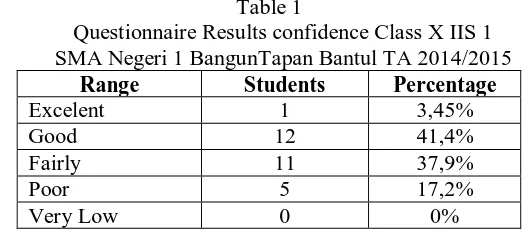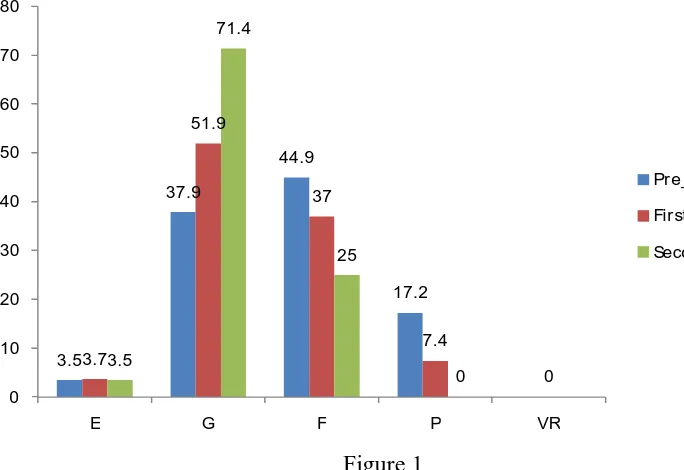ME – 20
IMPROVING THE STUDENTS’ CONFIDENCE IN LEARNING
MATHEMATICS THROUGH PROBLEM BASED LEARNING
Edi Susanto1, Suranten2
1
Student of Graduate School, Yogyakarta State University PendidEmail: [email protected]
2
Teacher of SMAN 1 Banguntapan Bantul Email: [email protected]
Abstract
The aspect of social attitude, especially self confident is one of the main goal in the implementation of 2013 Curriculum. This aspect is greatly needed by the students since it relates to the needs of students to achieve the learning objectives of mathematics. This notion requires a particular concern to improve the mathematics learning. However the fact shows that the students’ confidence in learning mathematics, especially students of SMAN 1 Banguntapan 1 needs to be improved. This research focuses on the effort to improve the students’ self confidence in the grade X of social study program 1, SMA Negeri 1 Banguntapan.
The type of this research is a classroom action research designed in several cycles thraught following steps: (1) planning, (2) implementation, (3) observation, and (4) reflection. The data collection technique used in this research is observation and questionnaires. The instrument is a questionnaire of self confidence of the students and the sheets of learning feasibility. The results finding shows the improvement of the students’ self confidence in learning mathematics throught the implementation of problem-based learning (PBL) equipped by students’ worksheet on which stages adapted with the problem based learning (PBL), the results of the reflection of each cycle and its improvements. It is proven by the students self confidence improvement in every cycle. The data of pre-cycle showes 37.93% and it increases into 51.85% in the first cycle. For the second cycle, the students' self confidence reaches 71.43%.
Keyword: Self Confidence, Problem Based Learning
Introduction
In learning of mathematics many aspects that affect the achievement of learning outcomes. One of these aspects are students' confidence. According to Eggen & Kauchak (2010, p.297) self confidence is a statement that describes a belief, an idea cognitive acceptable if properly without the need to consider other things that support it. It shows the students' learning, especially in solving math problems confidence is very important. This is consistent with the results of research by Hannula, Maijala & Pehkonen (2004) which indicates that the learning of mathematics influenced by beliefs, especially confidence. The confidence students have strong links with mathematics achievement. Beside that, the results of research by Sugiman (2009) shows that the mathematical beliefs is one of the most important aspects in the affective dimension.
Table 1
Questionnaire Results confidence Class X IIS 1 SMA Negeri 1 BangunTapan Bantul TA 2014/2015
Range Students Percentage
Excelent 1 3,45%
Good 12 41,4%
Fairly 11 37,9%
Poor 5 17,2%
Very Low 0 0%
Data indicates that only 41,4% of the students who have self confidence in the good category and there are one student in the category are excelent. These suggests that the need to efforts to improve students' confidence in learning of mathematics, especially in class X IIS I SMA Negeri 1 Banguntapan.
One attempt to resolve the problems faced by students in learning of mathematics is learning to design in accordance with the needs of students. Learning model that provides the opportunity for students to practice and learn to develop students' confidence. Besides the learning model can also involve students' participation in the learning mathematics process optimally. One of the learning model suggested in implementation of 2013 curriculum are problem based learning model. Fogarty (1997, p.2) say that, problem based learning is defined as a model curriculum designed using real-life problems. These include the problem of unstructured, open-ended problem or issue ambiguous. Results of research by Khususwanto (2013) at the junior high school students showed that the results of the questionnaire confidence (self-confidence) reflects the level of confidence both in the student category of the group of students who take lessons with resource-based learning approach (RBL).
Stages of model of problem based learning which is used in this research consists of stages by (Duch, Groh, & Allen, 2001: p.7; Tan, 2004: p.10; Arend & Kilcher, 2010: p.33; Eggen & Kauchak, 2012: p.307). The stages of learning, namely: (1) the presentation of the problem, (2) planning problem solving, (3) investigation of the problem, (4) analyze and evaluate, and (5) analyze and evaluate. Tan (2004: p. 9-10) mentions one of the characteristics of PBL is a challenging problem of knowledge, attitudes, and competence of students. In addition, other characteristics self-directed learning is primary. This shows the problem based learning one of the main focus is the development of students' attitudes.
Confidence that the focus on this research consisted of five aspects adopted by Lauster (Gufron, 2010: p. 34-38), namely: (a) confidence in the ability of self, (b) optimistic, (c) the objective, (responsible) and (5) the rational and realistic. Five of these aspects into a measuring instrument students confidence in learning of mathematics.
Research methods
of managing the activities of the teacher in the classroom by using a model of problem-based learning and learning activities of students in participating is at least 80% done.
Results and Discussion
Data obtained from this study include the results of the questionnaire confidence pre-cycle, the first pre-cycle, and the second cycle and observations by using sheets feasibility study first cycle and second cycle. The results of the students' confidence in pre-cycle, the first cycle, and the second cycle as shown in figure 1 below:
Figure 1
Data self confident of students pre-cycle, cycle I, and cycle s II
The graph above shows an increase in the percentage of students' confidence in each cycle for the good category. However low confidence and self-esteem category quite experienced decreases each cycle. At the end of the cycle of self-confidence of students with high category reached 71.4%. In addition, the feasibility research has increased from the first cycle and the second cycle as shown in figure 2 below:
a. Implementation Measures Based Research
Actions are taken in the first cycle based on the results of the initial observation and action planning are as follows:
1. Implementing the learning process based lesson plans that have been prepared.
2. Repeating material as a linear equation system apperception. She also conveyed the learning objectives and measures learning model is used, which is a step problem-based learning.
3. Students were based on the results of the initial questionnaire and categorized as having low confidence placed in the group category with the front seat to be easily observed. Students are placed with other students who have fairly category or good category. 4. Implementing learning problem based learning as outlined in the lesson plans and
worksheets (LK).
b. Reflection Cycle I and Cycle II Alternative Measures
The things which have been achieved in the first cycle, including the percentage of self confidence of students in the good category of 51.85% (14 students) and learning has been accomplished 75%. Some of the findings were found among which: (1) the limited time spent, (2) students are still difficulties in formulating the question of observations, (3) the majority of students in the first cycle tends not dare to present the results to the class, (4) students are still having trouble observe the presentation of LKS. Based on these reflections, compiled the planning the second cycle to overcome the things that has not been achieved in the cycle I. The action performed on the second cycle based on the reflection of the first cycle are: (1) set of learning time in accordance with the material, (2) provide motivation to students, (3) provide a list of questions related to the learning objectives, (4) motivate students to present their work in front of the class, (5) improve the worksheet (LK) and provide student activities, (6) provide guidance to students who have confidence in low category.
Conclusion, Implications, and Suggestions a. Conclusion
The application of the model problem based learning can improve students' confidence in learning of mathematics on class X IIS 1 SMA Negeri 1 Banguntapan. This increase is the result of reflection from the action and the findings in the previous cycle by applying PBL step. The increase among others, by: (a) the presentation of the activities of the problem, the student confidently prepare questions, (b) through the stages of investigation, optimistic and responsible students solve problems, and (c) through the presentation of the results, the students have confidence in yourself and bold expression. Increased confidence in the students' learning of mathematics is shown from the data pre-cycle that has the confidence of good category only 37.93%. After the action there is an increase in the first cycle is 51.85% of the students in good category. The results of the first cycle of reflection to be improved so that the action on the second cycle students' confidence in the high category increased to 71.43%.
b. Implication
This research is expected to benefit some parties, as follows.
2. Teachers. Getting an experience in the learning process, particularly in the use of problem-based learning models in learning mathematics. Teachers can add insight into learning of mathematics strategies that can be applied to the learners.
3. School. Get information about the application of the model problem based learning. Such information may be used or applied in other classes and other material, so as to improve the quality of teaching of mathematics, especially in improving students' confidence in learning of mathematics.
4. Researchers. For researchers can adds to the knowledge and at the same direct experience in conducting action research. Such knowledge can be used in the development and innovation of learning of mathematics and action research further.
c. Suggestion
The suggestion is based on the results and discussion are as follows:
1. Should be in the implementation of problem-based learning model of teacher can prepare worksheets (LK) own and use a real problem
2. Teachers should provide relevant questions with the aim of delivering the material, so if the question does not arise from the student teachers can guide students
3. In the application of problem-based learning model should prepare a small group of early learning.
Bibliography:
Arends, R. I, & Kilcher, A. (2010). Teaching for student learning becoming an accomplished teacher. New York: Routledge
Duch, B., J., Groh, S., E., & Allen, D., E. (2001). The power of problem-based learning a practical “how to” for teaching undergraduate courses in any discipline. Virginia: Stylus Publishing, LLC
Eggen, P., & Kauchak, D. (2012). Strategi dan model pembelajaran mengajar konten dan keterampilan berpikir. (Terjemahan Satrio Wahono). Boston: Pearson Educational, Inc. (Buku asli diterbitkan tahun 2012)
Fogarty, R. (1997). Problem based learning & curriculum models for the multiple intelligences classroom. Glenview: Pearson SkyLight
Hannula, M.S., Maijala, H., & Pehkonen, E. (2004). Development of understanding and self confidence in Mathematics; grades 5-8. Journal of Mathematics education, 3, 17-24.
Diambil pada tanggal 25 November 2014 dari
http://www.emis.de/proceedings/PME28/RR/RR162_Hannula.pdf
Krismar Wartiningsih. (2011). Pengaruh model kooperatif pada pembelajaran trigonometri terhadap prestasi akademik, toleransi, dan kepercayaan diri siswa SMAN di Klaten. Tesis Magister, tidak diterbitkan. Pascasarjana Universitas Negeri Yogyakarta.
Khususwanto. (2013). Pembelajaran matematika dengan pendekatan resource-based learning untuk meningkatkan kemampuan berpikri kreatif matematis dan self conficdence siswa SMP. Tesis Magister, tidak diterbitkan. Universitas Pendidikan Indonesia
Sugiman. (2009). Aspek keyakinan matematik siswa dalam pendidikan matematika. Diakses pada tanggal 30 desember 2014 di
http://staff.uny.ac.id/sites/default/files/131930135/2009b_KYM.pdf

